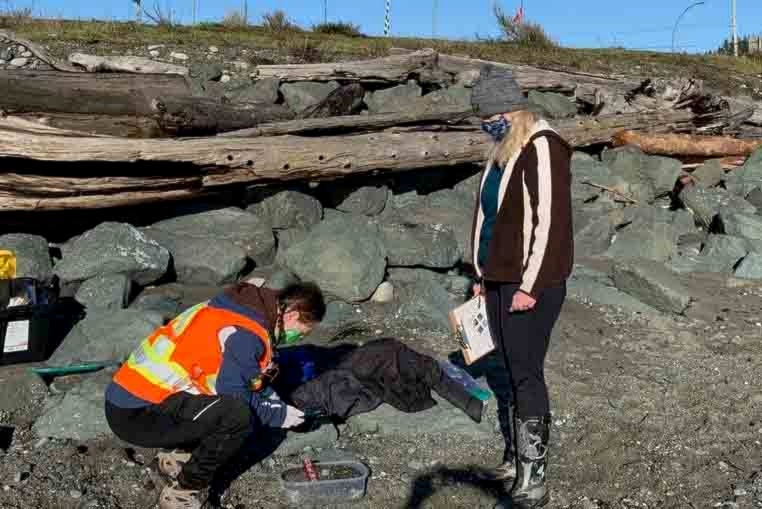Submitted by Project Watershed
Special to The Record
Here in the Comox Valley, our local beaches have a story to tell about a small fish that is so much more. Maybe you’ve seen Project Watershed out on local beaches, with measuring tapes and high visibility vests, trying to learn more about this small fish with a big impact.
Forage fish, sometimes referred to as bait fish, are an important food source for so many large, charismatic sea creatures in the Pacific Northwest. Forage fish, which includes herring, anchovies, surf smelt, and Pacific sand lance, are the main prey type for chinook salmon, which in turn is the key food item for other larger animals like resident orcas, seals, and sea lions.
The survival and abundance of these fish is just a part of their story. We must also look to their key habitats, the beaches. Pacific sand lance (PSL) and surf smelt (SS) are beach spawners, needing specific size and coarseness of sediment to lay their eggs. Thus, the local beach habitat is important to protect.
| Top - Surf Smelt (SS) and Bottom - Pacific Sand Lance (PSL) (Photo: K. Perry). |
Beaches also form the nursery habitat for eggs. For this reason, forage fish expert Ramona deGraaf refers to Pacific sand lance and surf smelt as “Beach Babies.” These two forage fish species spawn in sediments of a specific size, ranging from sand to fine gravel. Comox beaches with this sediment size include Goose Spit, Kye Bay, and Air Force Beach. Beaches made of larger or smaller sediments aren’t suitable for forage fish. Cobbles and boulder beaches do not allow PSL and SS to hide from predators, while fine sediment like silt and mud can suffocate the fish and reduce oxygenation in the sand which hinders egg development.
Seasonality also plays a part in the forage fish’s search for suitable habitat. The sediment on these beaches in Comox Valley and throughout the Pacific Northwest has been observed to change based on the seasons, thus impacting the spawning habitat for SS and PSL. Surf smelt use fine gravel with a sand base for spawning between May and September, while Pacific sand lance prefer to spawn on sandy beaches between November and February. Pacific sand lance will also use beaches to bury during the winter months. Big winter storms erode small sediment in some areas and bring in larger sediments and debris in others. Since different forage fish use the beaches at different times, it is important to ensure the local beaches remain suitable habitat for both species year-round.
In the last 100 years, we have seen some major changes in beach sediments because of anthropogenic influences such as urban development and climate change. Shoreline modification, such as hard armoring, for erosion control, or dyking, can transform beaches to have either more or less sediment, as well as different sediment sizes. Rising sea temperatures and storm intensification resulting from changing climates can also result in shifts in sediment size and suitability.
The importance of forage fish to our marine food web and ecosystems throughout B.C. is well-known, but there is much still to learn about these small fish, such as their abundance, local habitats, and priorities for habitat restoration. Project Watershed has been researching forage fish for the past three years through the engagement of community organizations, citizen scientists, and scientific and academic partners like Georgie Harrison (NIC faculty member) and enthusiastic North Island College students. These collaborations support mapping, field validation, and restoration. It is also a big part of the education and outreach work that helps support the spread of knowledge about the importance of beach habitats for Pacific sand lance and surf smelt, which in turn benefits habitat conservation for future generations.
Citizen scientist volunteers have joined Project Watershed staff to collect a variety of data that help determine which beaches Pacific sand lance and surf smelt use for spawning. While many beaches in the Comox Valley have been found to support Pacific sand lance, we are still on the hunt for the elusive surf smelt. There are still gaps in the forage fish story including collecting local ecological knowledge.
There are lots of ways to support this project in COVID health regulation-friendly ways. We host small group field sampling events, post-processing activities (sieving, vortexing, and hunting for eggs under a microscope), and financial donations to continue this work are always welcomed. To find out more, or to offer financial support for Project Watershed initiatives, visitprojectwatershed.ca/
This project has been made possible through support from BC Salmon Restoration and Innovation Fund (BCSRIF), North Island College (NIC), Pacific Salmon Foundation (PSF), and the K’òmoks First Nation, as well as community partners, government and local funders, community groups like Comox Valley Nature, Conservancy Hornby Island (CHI), Friends of Cortes Island Society (FOCI), community members on Quadra Island, and the Hakai Institute.
